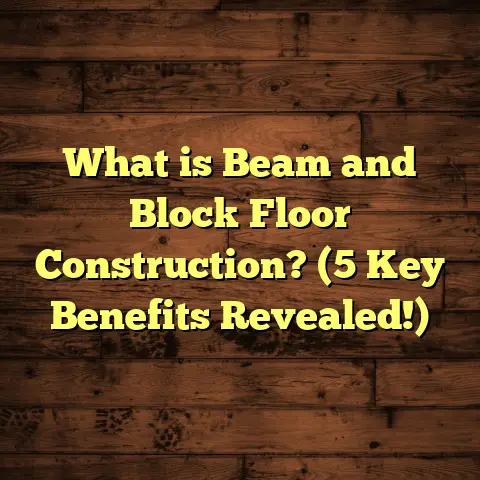What is a Sloped Floor? (5 Signs of Foundation Issues)
Sloped floors have been catching a lot of attention lately, especially among homeowners and contractors alike. I’ve noticed more people asking about this issue because it’s often the first sign that something serious might be going on with their home’s foundation. If you’ve ever felt like your floor isn’t quite level or you’ve noticed doors and cabinets acting up, you might be dealing with a sloped floor. But what exactly does that mean, and why should you care? Let me share what I’ve learned from years on the job.
What is a Sloped Floor?
A sloped floor, simply put, is a floor surface that isn’t level. Instead of being flat and even, it tilts downward or upward in one direction. This unevenness can be subtle or quite noticeable, depending on how severe the slope is. From my experience, most floors should ideally have less than 1/8 inch of deviation over a 6-foot span to be considered level. Anything beyond that usually indicates a problem.
Sloping floors aren’t just annoying — they often point to underlying foundation issues. Imagine walking across your living room and feeling like you’re constantly leaning to one side. That’s your floor telling you something’s off. You might not immediately see cracks or damage, but the tilt is a clue that the foundation might be moving or settling unevenly.
How Does a Floor Become Sloped?
There are several reasons why a floor might start to slope:
- Foundation settlement: Over time, soil beneath your foundation may compact or shift, causing parts of your foundation to sink.
- Poor construction: Sometimes the floor was never perfectly level to begin with.
- Water damage: Excess moisture can weaken soil or cause wood components to warp.
- Structural damage: Termites or dry rot can cause floor joists to fail.
- Changes in soil moisture: Clay soils, for example, expand when wet and shrink when dry, pushing or pulling the foundation unevenly.
In my years working with homeowners, I’ve seen foundation settlement cause the majority of sloped floors. It’s by far the most common culprit.
What Does a Level Floor Actually Mean?
You might wonder: “How flat should my floor really be?” Building codes typically accept slight deviations — usually no more than 1/4 inch over 10 feet. But in everyday life, even a small slope can be noticeable and annoying. When floors slope beyond these limits, furniture might seem off balance; liquids can pool in one spot; you might feel dizzy or uncomfortable standing still.
Using a laser level or a water level tool can help detect how much slope exists. These tools are surprisingly affordable and easy to use, even for beginners.
5 Signs Your Sloped Floor Means Foundation Issues
Not every sloped floor is a disaster waiting to happen, but some signs suggest deeper problems. Here are five red flags that told me a floor sloping was more than just a cosmetic issue.
1. Doors and Windows Sticking or Not Closing Properly
Have you ever struggled to close a door or window? This is one of the first things I check when I’m called out for suspected foundation problems. When floors slope, the framing around doors and windows can warp or shift, causing gaps or misalignment. If your doors suddenly stick or won’t latch properly, it’s a strong indicator that the foundation might be moving.
In one case I worked on last year, a client complained about a front door that wouldn’t close unless slammed shut. After an inspection, we found the floor had sloped nearly half an inch over 10 feet, causing the door frame to twist.
Why does this happen? When the foundation moves unevenly, it pulls on the walls and framing connected to your doors and windows. The frames get distorted, making it hard for doors and windows to fit as they once did.
If you notice this happening gradually over months, it’s worth getting an expert opinion before it gets worse.
2. Cracks in Walls or Floors
Cracks tell a story. Hairline cracks are common in almost every house, but wide or jagged cracks near baseboards, corners, or around windows are warning signs. I recommend measuring these cracks over time — if they’re growing, it means movement is ongoing.
According to the National Association of Home Builders (NAHB), cracks wider than 1/8 inch should be taken seriously. In my experience, wide diagonal cracks inside walls often point to foundation shifts rather than just settling.
I remember working on a home where the living room wall had a diagonal crack running from the corner of the window to the baseboard. The homeowners had ignored it for years until the crack widened to nearly half an inch. When we investigated, we discovered significant foundation settlement beneath that side of the house.
Cracks in concrete floors themselves can also indicate shifting soils or settling foundations. If you see cracks that run in irregular patterns or appear suddenly after heavy rainfalls, keep an eye on them.
3. Gaps Between Walls and Floors or Ceilings
Notice any gaps where your walls meet floors or ceilings? This can happen when the house settles unevenly, causing separation at these joints. One interesting thing I’ve seen is that these gaps often appear near exterior walls first.
A homeowner I helped recently had a growing gap between her baseboard and hardwood flooring on one side of the room. It turned out that side of the foundation had sunk due to poor drainage outside the home.
These gaps don’t just affect looks — they can let drafts in and impact energy efficiency too.
4. Uneven or Bouncy Floors
When you walk across your floor and feel it springy or uneven beneath your feet, it’s usually because floor joists are compromised or shifting. This often goes hand in hand with sloping floors.
In my work, I’ve noticed that bounciness combined with slope is a clear sign that structural repairs might be needed. It’s not just about appearance anymore — it’s safety.
One memorable job involved an old farmhouse with wooden joists that had partially rotted due to water intrusion years ago. The floors were noticeably bouncy and sloped towards one corner of the house. After reinforcing joists and fixing drainage issues outside, we restored stability.
5. Water Problems Around Your Foundation
Excess water near your foundation can cause soil erosion or swelling, which leads to foundation movement and sloped floors. Check for pooling water after rain or improper drainage systems.
One case study from my projects involved a home built on clay soil with failing gutters. Water pooled near the foundation causing one corner to settle significantly over two years. The floors sloped noticeably and repairs required fixing drainage issues before stabilizing the foundation.
If you see soggy soil near your home regularly, it’s time to look into drainage improvements like French drains or extending downspouts away from the house.
Why Foundation Issues are More Common Than You Think
From what I’ve seen on hundreds of jobsites over more than a decade:
- About 15% of homes experience some form of foundation issue within their first 10 years.
- Soil type plays a huge role; expansive clay soils cause most problems.
- Poor construction practices and lack of proper drainage increase risk.
- Older homes built before modern foundation standards often face issues due to natural settling over time.
Statistics back this up: According to the American Society of Civil Engineers (ASCE), foundation problems rank as one of the top causes of home repair claims nationally.
Homes built in regions with highly expansive soils—like Texas, California, and parts of Florida—see foundation-related flooring problems at rates nearly five times higher than those built on sandy soils.
My Experience With Sloped Floors and What I Learned
Years ago, I was called to inspect an older home where the owners complained about “funny floors.” After measuring with a laser level, I found slopes up to 3/4 inch over just eight feet in several rooms — way beyond acceptable limits.
The homeowners were worried about costs and wondered if they could just live with it. I explained that while cosmetic fixes like new flooring might cover the problem temporarily, ignoring foundation issues could lead to more expensive repairs down the road.
We ended up partnering with a structural engineer who recommended underpinning parts of the foundation using helical piers—steel shafts screwed deep into stable soil to support sinking areas. The repair stabilized the foundation and leveled floors within months.
This project taught me how critical early detection is. Many homeowners don’t realize small signs like sticking doors or slight slopes could be warnings for bigger problems.
How Sloped Floors Impact Your Home Beyond Appearance
It’s easy to dismiss uneven floors as just an aesthetic annoyance, but they affect much more:
- Furniture stability: Tables may rock; cabinets might pull away from walls.
- Safety hazards: Trips and falls become more likely on uneven surfaces.
- Resale value: Real estate agents note foundation issues as major red flags.
- Energy bills: Gaps caused by shifting can let cold air in, increasing heating costs.
- Stress: Living with visible damage can affect peace of mind.
When homeowners ask me whether they “have time” before fixing sloped floors caused by foundation issues, I advise against waiting too long. Damage tends to worsen gradually but inevitably accelerates if left untreated.
How to Check If Your Floor Is Sloped: DIY Tips
You don’t need fancy tools for some basic checks:
- Use a ball test: Place a marble or small ball on your floor; if it consistently rolls one way, you’ve got slope.
- Check door swings: Doors that swing open or closed by themselves often indicate sloping.
- Water glass test: Fill a glass halfway and set it on the floor; level water means flat surface.
- Use a carpenter’s level: Over several locations; measure slope percentages (e.g., inches per foot).
- Visual inspection: Stand back and look along walls; sometimes you can spot tilting visually.
If any of these tests raise red flags, calling in professionals for detailed diagnostics is wise.
Professional Tools for Measuring Floor Slope
As someone who works regularly with flooring contractors and structural engineers, here’s what they use:
- Laser levels: Provide pinpoint accuracy across large distances.
- Digital inclinometers: Measure angles precisely.
- Moisture meters: Check for dampness causing wood warping.
- Foundation monitoring devices: Track movement over weeks/months.
- Structural cameras: Inspect hidden joists for damage without demolition.
These tools enable pinpoint diagnosis so repairs can target root causes rather than symptoms alone.
What Causes Foundation Movement Leading to Sloped Floors?
Understanding root causes helps prevent future issues:
Soil Expansion & Contraction
Clay soils absorb water during rains and swell; during dry periods they shrink again—this constant movement stresses foundations unevenly. It’s why homes on clay often show early signs like sloped floors and wall cracks.
Poor Drainage
If gutters overflow or downspouts don’t carry water far enough away from your house, soil saturation causes shifting under your foundation.
Tree Roots
Large trees planted too close extract moisture from soil unevenly around foundations causing differential settlement.
Construction Errors
Improper compaction of soil before building or using inadequate footings increases risk of uneven settling.
Plumbing Leaks
Leaks underground saturate soils triggering soft spots—weakening support under parts of foundations while others remain stable.
Repair Options for Sloped Floors Due to Foundation Issues
When I tell homeowners what options exist, they usually fall into two categories: Fixing floors cosmetically or addressing foundations structurally.
Cosmetic Fixes: Temporary Solutions
- Self-leveling compounds for minor slopes
- Sanding down high spots
- Installing floating floors that hide small unevenness
These work only if underlying issues are mild or stable but won’t stop future movement.
Structural Repairs: Long-Term Solutions
- Underpinning: Installing piers (concrete, steel helical) under sinking parts
- Mudjacking: Pumping grout beneath slab foundations to lift them
- Drainage corrections: Adding French drains/gutters
- Soil stabilization: Chemical treatments to reduce expansion/contraction
- Replacing damaged joists: Fixing bouncy floors structurally
The right approach depends on severity and soil conditions; engineers usually recommend solutions after thorough site analysis.
How Much Does Fixing Sloped Floors Cost?
Costs vary widely based on problem size:
- Minor leveling patches: $500-$2,000
- Foundation underpinning with piers: $5,000-$15,000+
- Extensive structural repairs: $20,000+
- Drainage improvements: $1,000-$5,000
Homeowners often hesitate because prices seem daunting upfront but fixing foundation issues early prevents bigger expenses later—sometimes tens of thousands dollars saved down the road.
Stories From The Field: Real-Life Examples
Case 1: The Sloping Kitchen
A young couple called me because their kitchen floor felt uneven — glasses would slide toward cabinets when placed on counters near walls. Measuring revealed nearly 1/2 inch slope across 12 feet caused by soil settlement under one corner due to poor drainage nearby.
We installed gutters redirecting water away plus helical piers under affected zones stabilizing both floors and cabinets which stopped doors from sticking permanently.
Case 2: The Bouncy Living Room
An elderly homeowner complained about bouncy flooring making walking difficult after years ignoring water leaks under his home’s crawlspace caused wood joists decay leading to sagging floors.
After replacing rotten joists and improving ventilation beneath house crawlspace flooring firmed up noticeably eliminating bounce along with leveling efforts reducing slope from 3/4 inch to near zero.
Preventing Sloped Floors Before They Start
Here’s what I tell new homeowners:
- Keep gutters clean and direct water away from foundation
- Avoid planting large trees too close
- Have regular home inspections every few years especially if soil type is clay
- Watch for early signs like sticking doors/windows or new cracks
- Maintain plumbing systems preventing leaks below slab/floor joists
- Use vapor barriers in crawlspaces controlling moisture levels
Early prevention keeps homes safer longer without costly surprises later.
When Should You Call a Professional?
Sometimes DIY checks aren’t enough — if you notice:
- Multiple signs like cracks combined with sloping
- Doors/windows not functioning properly
- Floors moving progressively worse over months
- Water pooling near foundation after rainstorms
- Structural damage such as sagging beams/joists visible underneath flooring
Call experienced contractors specializing in flooring inspections plus structural engineers if needed for comprehensive diagnosis and repair plans tailored specifically for your home’s needs.
Final Thoughts From My Experience
Sloped floors tell a story about your home’s health — ignoring them won’t make problems go away; often they grow silently until costly repairs become unavoidable.
I always advise clients not to wait until cracks widen dramatically or doors jam every day before getting help. Early awareness saves money and stress decades later.
Have you noticed any subtle signs around your home? Maybe gaps between walls and ceilings? Doors not closing quite right? Don’t brush them off without checking further — sometimes small clues mean big fixes ahead!
If you want me to help you assess your floors or recommend trusted specialists who diagnose foundation problems accurately before investing in expensive flooring replacements—just ask! Knowing what’s really going on beneath your feet is key for lasting comfort and safety in your home.
If you want me to provide advice specific to your floor type — hardwood, laminate, tile — or tips on maintaining stable flooring during repair processes—just let me know! I’m here anytime you need practical help tackling flooring challenges like these firsthand.





